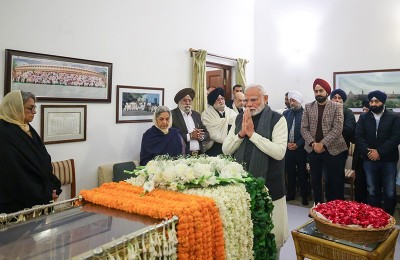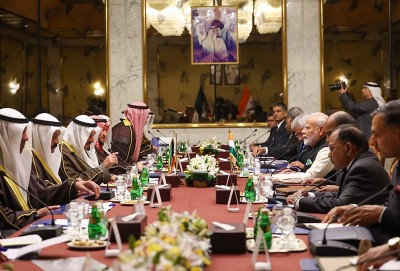 Taliban
Taliban
Afghanistan: The predator turns target
On April 8, 2022, Taliban fighters stormed the Qassan Valley in the Deh Salah area of Andarab District in Baghlan Province and took control of the upper area of Darband Kaasa Traash and Darra e Jar, the strongholds of the National Resistance Front (NRF). NRF fighters retaliated and, in the ensuing clashes, at least 11 Taliban fighters were killed and several injured.
According to an NRF release, the Taliban fighters fled Dara-e-Jar after the attack. The current cycle of fighting in the area started on April 4, 2022.
On April 3, 2022, NRF fighters targeted a vehicle carrying the security chief of the Taliban, Mawlawi Rashad, in the city of Faizabad, the capital of Badakhshan. While Rashad was severely wounded, two of his bodyguards were killed in the attack.
On April 1, 2022, NRF fighters ambushed the Taliban forces in the Hesarak area of Panjshir Province, killing 10 Taliban, and wounding another 12.
According to available data, since the formation of the NRF subsequent to the fall of Kabul to the Taliban on August 15, 2021, clashes between NRF and Taliban have resulted in at least 195 deaths (154 Taliban, 37 NRF and four civilians). Such attacks have not been limited to the northern provinces. Indeed, Sibghatullah Ahmadi, Spokesperson and Director of Strategic Communications, NRF, tweeted on March 3,
In the past eleven days, the NRF guerrillas and infiltrators in Kabul, Nangarhar, Baghlan, Panjshir, Takhar, Laghman, Kapisa, Kunduz, Faryab, Balkh, Parwan, Badakhshan, Jawzjan, Badghis, Sar-e-Pul, Ghor, Farah, Samangan, Logar, Herat and Maidan Wardak provinces have killed fifty-seven Taliban terrorist fighters and seriously wounded seventy-three other sabotagers (sic). Eleven of the NRF devoted fighters have been martyred during these attacks. Those who fight for freedom will not be forgotten. We will succeed.
Indeed, the NRF has reiterated, on several occasions, its resolve to overthrow the Taliban regime. On February 9, 2022, Ali Maisam Nazary, Head of Foreign Relations for the NRF, tweeted,
There's a humanitarian crisis in Afg [Afghanistan] because a terrorist group was allowed to hijack a whole country. The Taliban have kept Afg in a state of anarchy to exploit the situation for their own ends. The only solution to end this crisis is to remove the root cause, which is the Taliban.
In an interview published on January 18, 2022, Nazary claimed that the Taliban had weakened and become unorganized and NRF would take power again. He disclosed that NRF fighters would start their offensive attacks against Taliban by the end of the winter.
Earlier, on January 11, during his meeting with Afghanistan’s Acting Foreign Minister Amir Khan Muttaqi in Tehran, Iran, Ahmad Massoud, leader of the NRF, rejected the Taliban government’s offer of safe passage to the country. Ali Maisam Nazary, stated,
We rejected his offer. They are not owners of Afghanistan to allow or prevent us from entering our country. We control many parts of the Hindu Kush and Commander Massoud can return anytime he wants. He will be back in Afghanistan once his trips end.
These developments clearly indicate that Taliban celebrations over the claim on September 6, 2021, that all of Panjshir Province was under Taliban control and the armed resistance in Afghanistan has ended, were premature. The NRF opposition is likely to last.
There are other resistance forces as well. These include the National Resistance Council, which allegedly includes major anti-Taliban key figures of the past decades such as Abdurrab Rasul Sayyaf, Mohammad Younus Qonuni, Ata Mohammad Noor, Abdul Rashid Dostum, Muhammad Mohaqiq, Abdul Hadi Arghandiwal, and Engineer Mohammad Khan; the Unknown Soldiers of Hazaristan, referring to a part of central Afghanistan predominantly inhabited by the Hazara ethnic minority; the Liberation Front of Afghanistan; the Afghanistan Islamic National and Liberation Movement; the Afghanistan Freedom Front; the Freedom and Democracy Front, another apparent Hazara-centred resistance group; and the Freedom Corps that claims to be active in parts of the Takhar Province.
Moreover, the threat to the Taliban regime from Islamic State-Khorasan Province (IS-KP) remains strong. According to a United Nation (UN) report on the situation in Afghanistan released on January 28, 2022,
Attacks claimed by or attributed to ISIL-KP [IS-KP] increased and expanded beyond the movement’s previous areas of focus in Kabul and eastern Afghanistan. Between 19 August and 31 December, the United Nations recorded 152 attacks by the group in 16 provinces, compared to 20 attacks in 5 provinces during the same period in 2020. In addition to the de facto authorities, the group also targeted civilians, in particular Shia minorities, in urban areas.
The report further noted,
From 15 August to 31 December 2021, UNAMA [United Nations Assistance Mission in Afghanistan] documented more than 1,050 civilian casualties, including more than 350 civilian deaths. Suicide and non-suicide improvised explosive devices, attributed almost entirely to ISIL-KP, accounted for more than 850 civilian casualties, including nearly 300 deaths, and consisted mainly of sectarian attacks targeting civilians. Explosive remnants of war caused nearly 100 civilian casualties, mainly children; targeted killings related to ongoing armed conflict resulted in more than 50 civilian casualties; ground engagements between the de facto authorities and ISIL-KP or resistance groups resulted in almost 20 civilian casualties; and one aerial attack by the United States on 29 August, targeting ISIL-KP, resulted in the deaths of 10 civilians.
Since January 1, 2022, IS-KP-linked incidents have resulted in 39 deaths (17 Taliban, six IS-KP terrorists, and 16 in the Not Specified Category).
Interestingly, however, Foreign Minister Muttaqi claimed on April 4, 2022,
Da’esh [IS-KP] had no operations in the last four months. We could say that Afghanistan is a secure country right now.
Meanwhile, the Taliban’s own brutalities against the Afghans continue. Most recently, on April 2, 2022, the Taliban cruelly killed a young girl in the seventh district of Mazar-e-Sharif, first flogging her, then cutting off parts of her body with a razor blade, amputating one of her legs, and then firing 12 bullets at her half-dead body. In another such incident, on March 12-13, 2022, a 48-year-old shopkeeper, Ghulam Sakhi, was severely tortured and killed by the Taliban in the Mata village of Panjshir Province.
Moreover, the Taliban continues to rule the country according to its own interpretation of Islamic law. Accordingly, on March 23, 2022, it said schools for girls would be closed until a plan was drawn up in accordance with Islamic law and Afghan culture. A Ministry of Education notice announced, "We inform all girls' high schools and those schools that are having female students above class six that they are off until the next order." Girls’ schools were scheduled to reopen across Afghanistan after months of closure and before March 22, the Taliban had expressed itself in favour of the reopening. Reports indicate that Afghan women are no longer permitted to go over 45 miles (or 72 kilometres) from their homes without the company of a close male relative. Since their return to power, the Taliban has curtailed women’s rights and freedoms, creating an environment similar to what it had imposed between 1996 and 2001, when female education and most employment for women was banned, and the severest restriction had been placed on their movements and activity.
Meanwhile, this last-minute reversal of the decision on girls’ schools is seen as further proof of a rising ideological rift within the Taliban leadership. Andrew Watkins of the US Institute of Peace, noted, “This last-minute change appears to be driven by ideological differences in the movement... about how girls returning to school will be perceived by their followers.” Significantly, since the Taliban was restored to power in Kabul, there have been reports of increasing rifts within the leadership.
In the meantime, the humanitarian crisis is deepening. According to a UNAMA release of March 31, 2022,
More than 24 million people – or 60 per cent of the population – need humanitarian assistance to survive. Needs are 30 per cent higher than last year [2021] and acute hunger is a daily reality for half the population. Basic health, education and other services are severely strained, livelihoods have been crushed and households are spending 80 per cent of their meagre income on food.
Thus, apprehensions that the misery of the Afghan people would greatly increase with the Taliban returning to power have unfortunately been proven correct. Not surprisingly, Resolution 2626 (2022) adopted by the United Nations Security Council (UNSC) at its 8,997th meeting, on March 17, 2022, agreed that the mandate of the UNAMA would be extended through March 17, 2023.
Amidst the many disturbing developments in Afghanistan, the international community continues in its uncertainty about its stand on the legal status of the Taliban regime. The UN Secretary-General’s Special Representative for Afghanistan, Deborah Lyons, in her briefing to the UNSC on March 2, 2022, spoke in favour of the Taliban, arguing,
Let’s me make clear, that we do not believe that we can truly assist the Afghan people without working with the de facto authorities. This must be difficult for some to accept, but it is essential… Above all, the Taliban have told us that they should receive greater acknowledgement for the security that prevails in Afghanistan. In the six months since 15 August [2021] there has been a 78 percent decline in civilian casualties as a result of the reduction of the conflict.
On the other hand, a UN report released on February 3, 2022, noted,
The security landscape in Afghanistan changed dramatically on 15 August, when the Taliban took control of the country. There are no recent signs that the Taliban has taken steps to limit the activities of foreign terrorist fighters in the country. On the contrary, terrorist groups enjoy greater freedom there than at any time in recent history… Central Asian foreign terrorist fighters and ETIM/TIP [East Turkestan Islamic Movement/ Turkestan Islamic Party] members in Afghanistan have embraced the Taliban takeover. They look forward to international recognition of the Taliban, believing that the “terrorist” label will then be removed from them. They also anticipate that the Taliban de facto administration will provide them with refugee status and passports, enabling them to travel internationally.
Afghanistan remains insecure, unstable and fraught with conflict, its future uncertain.
There is no hope of any immediate relief to the people of the country, which super powers have invaded from time to time only to face defeat. In the devastation these powers leave behind, the misery of the people can only increase in the foreseeable future.
Worse, as political volatility increasingly afflicts the mischievous neighbour and Afghanistan’s ‘tormentor in-chief,’ Pakistan, the deepening crisis in Islamabad can only augment uncertainties in Kabul.
Support Our Journalism
We cannot do without you.. your contribution supports unbiased journalism
IBNS is not driven by any ism- not wokeism, not racism, not skewed secularism, not hyper right-wing or left liberal ideals, nor by any hardline religious beliefs or hyper nationalism. We want to serve you good old objective news, as they are. We do not judge or preach. We let people decide for themselves. We only try to present factual and well-sourced news.







